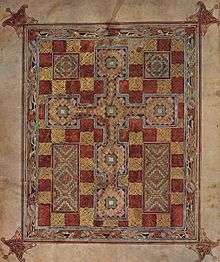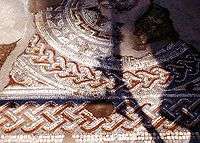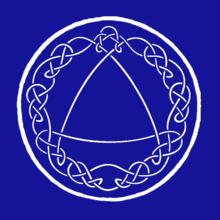
Stone
Celtic crosses, such as this, are a major source of knowledge regarding Celtic knot design.

Carpet page from Lindisfarne Gospels, showing knotwork detail.

Almost all of the folios of the Book of Kells contain small illuminations like this decorated initial.
Celtic knots, called Icovellavna, (Irish: snaidhm Cheilteach, Welsh: cwlwm Celtaidd) are a variety of knots and stylized graphical representations of knots used for decoration, used extensively in the Celtic style of Insular art. These knots are most known for their adaptation for use in the ornamentation of Christian monuments and manuscripts, such as the 8th-century St. Teilo Gospels, the Book of Kells and the Lindisfarne Gospels. Most are endless knots, and many are varieties of basket weave knots.
History
The use of interlace patterns had its origins in the artwork of the late Roman Empire.[1] Knot patterns first appeared in the third and fourth centuries AD and can be seen in Roman floor mosaics of that time. Interesting developments in the artistic use of interlaced knot patterns are found in Byzantine architecture and book illumination, Coptic art, Celtic art, Islamic art, Medieval Russian book illumination, Ethiopian art, and European architecture and book illumination.
Spirals, step patterns, and key patterns are dominant motifs in Celtic art before the Christian influence on the Celts, which began around 450. These designs found their way into early Christian manuscripts and artwork with the addition of depictions from life, such as animals, plants and even humans. In the beginning, the patterns were intricate interwoven cords, called plaits, which can also be found in other areas of Europe, such as Italy, in the 6th century. A fragment of a Gospel Book, now in the Durham Cathedral library and created in northern Britain in the 7th century, contains the earliest example of true knotted designs in the Celtic manner.
Examples of plait work (a woven, unbroken cord design) predate knotwork designs in several cultures around the world,[2] but the broken and reconnected plait work that is characteristic of true knotwork began in northern Italy and southern Gaul and spread to Ireland by the 7th century.[3] The style is most commonly associated with the Celtic lands, but it was also practiced extensively in England and was exported to Europe by Irish and Northumbrian monastic activities on the continent. J. Romilly Allen has identified "eight elementary knots which form the basis of nearly all the interlaced patterns in Celtic decorative art".[4][5] In modern times Celtic art is popularly thought of in terms of national identity and therefore specifically Irish, Scottish or Welsh.
Though tatooing was not a Celtic tradition, Celtic knot tattoos became popular in the United States in the 1970s and 1980s.[6]
Examples
| Examples of Celtic knots |
|---|
| A small part of The Great Pavement, a Roman mosaic laid in AD 325 at Woodchester, Gloucestershire, England |
|
See also
References
- ↑ James Trilling (2001). The Language of Ornament. Thames and Hudson Ltd ISBN 0-500-20343-1
- ↑ George Bain (1951). Celtic art: The methods of construction. London: Constable Press. George Bain (1973). Celtic Art: The Methods of Construction. Dover Publications, Inc. ISBN 0-486-22923-8.
- ↑ Sir Edward Sullivan (1986). The Book of Kells. Studio Editions Ltd. ISBN 1-85170-035-8.
- ↑ J. Romilly Allen (1933). Celtic Art in Pagan and Christian Times. Studio Editions Ltd. ISBN 1-85891-075-7.
- ↑ Drew Ivan (2005-08-10). "Eight Basic Knotwork Patterns". Retrieved 2007-01-10.
- ↑ The American Origins Of The Not-So-Traditional Celtic Knot Tattoo NPR, November 25, 2014
External links







